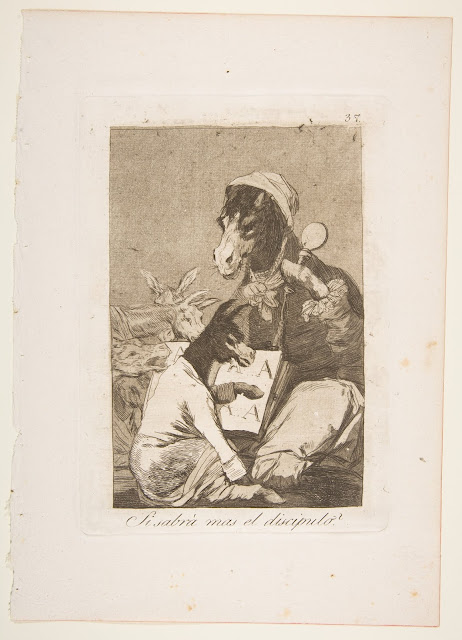Might not the pupil know more? (Si Sabrá mas el discipulo?) by Francisco Goya (Interpretation and Analysis)
 |
| Si Sabrá mas el discipulo? Source: MET Museum |
This print, the first in the Capricho’s so-called asses sequence—which presents a series of images of donkeys acting in human roles—provides a direct satire of Spanish education. Here, a donkey masquerades as a teacher, instructing other, young donkeys. A contemporary description (from the Ayala Commentary) sarcastically comments, “teachers who are asses cannot but produce students that are asses.” In this context, the word ass has the idiomatic double meaning of idiot and donkey, a play on the subject of the image. The image suggests the bad teachers make bad students, perpetuating the cycle of ignorance and indolent academic practice. The ridiculous image of a donkey as an instructor represents the Spanish educational system, implying that most Spanish teachers are as knowledgeable as farm animals.
Educational reform was one of the first targets of the Spanish enlightenment. After Charles III took the universities under royal control following the expulsion of the Jesuits, enlightened thinkers attempted to modernize university curriculums by introducing subjects such as physics, astronomy, political theory, law, and epistemology. Although some professors and students embraced these changes, in many cases, these wide sweeping reforms were not successful. Furthermore, the Inquisition banned the works of major, French enlightenment writers, such as Voltaire and Rousseau, further narrowing the scope of Spanish academic thought. Goya’s print expresses his frustration with Spain’s ineffective approach to education.
Along with print thirty-nine, And so was his grandfather, Might not the pupil know more? is one of two Capricho images of donkeys reading books. This motif mocks false intellectualism and calls for fact based knowledge to be imparted in education.
Disclaimer: I’m not an art historian or an expert on this topic. The above is my opinion, based on my interpretation of my foreknowledge of art and history. If I’ve done any additional research, I’ll note it above.



Comments
Post a Comment